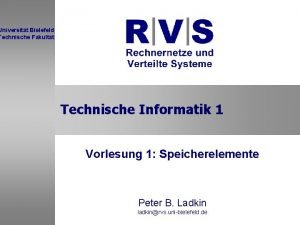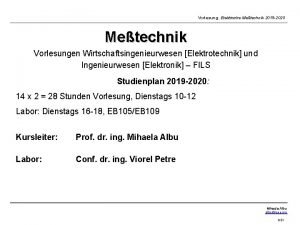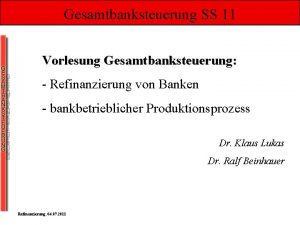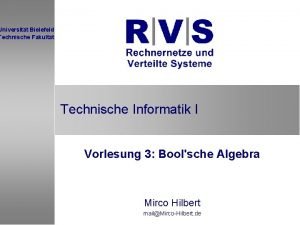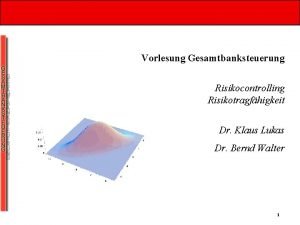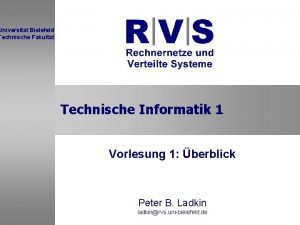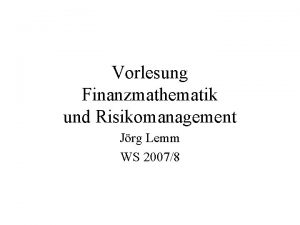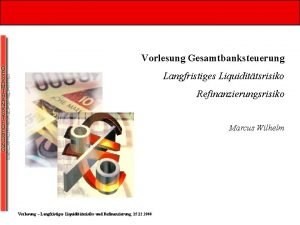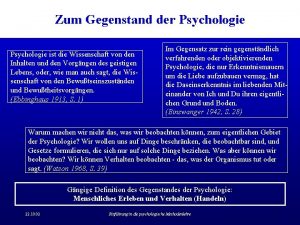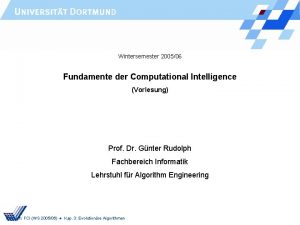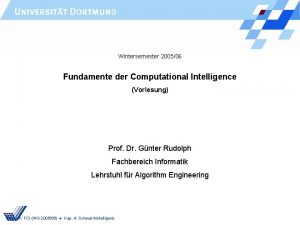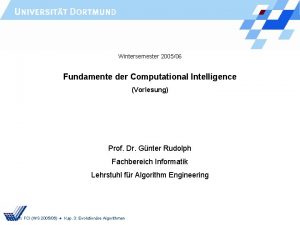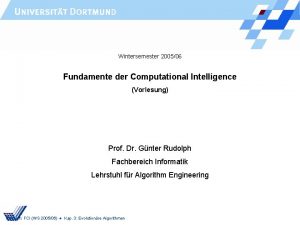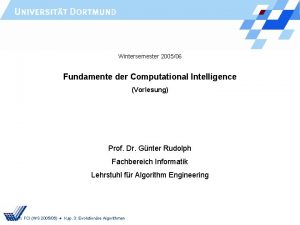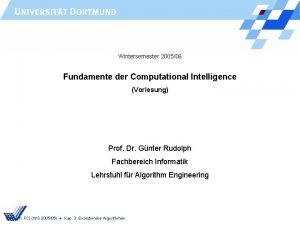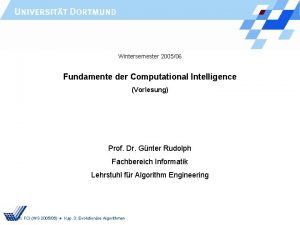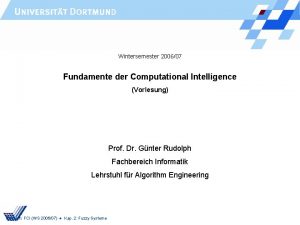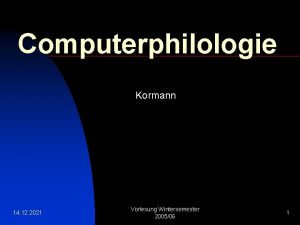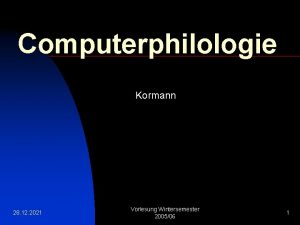Wintersemester 200506 Fundamente der Computational Intelligence Vorlesung Prof











- Slides: 11

Wintersemester 2005/06 Fundamente der Computational Intelligence (Vorlesung) Prof. Dr. Günter Rudolph Fachbereich Informatik Lehrstuhl für Algorithm Engineering Rudolph: FCI (WS 2005/06) ● Kap. 2: Fuzzy Systeme

Kapitel 2: Fuzzy Systeme Inhalt ● Fuzzy Mengen ● Fuzzy Relationen ● Fuzzy Logik ● Approximatives Schließen (Teil 1) ● Approximatives Schließen (Teil 2) Heute ● Fuzzy Regelung Freitag ●… Rudolph: FCI (WS 2005/06) ● Kap. 2: Fuzzy Systeme 2

Approximatives Schließen (Teil 2) Bisher: ● p: IF X ist A THEN Y ist B → R(x, y) = Imp( A(x), B(y) ) ● Regel: Fakt: Folgerung: Regel als Relation; Fuzzy Implikation IF X ist A THEN Y ist B X ist A‘ Y ist B‘ → B‘(y) = supx X t( A‘(x), R(x, y) ) Kompositionsregel der Inferenz Also: ● B‘(y) = supx X t( A‘(x), Imp( A(x), B(y) ) ) Rudolph: FCI (WS 2005/06) ● Kap. 2: Fuzzy Systeme 3

Approximatives Schließen (Teil 2) Hier: A(x) = B‘(y) = 1 für x = x 0 0 sonst scharfe Eingabe! supx X t( A‘(x), Imp( A(x), B(y) ) ) sup t( 0, Imp( A(x), B(y) ) ) = x ≠ x 0 für x ≠ x 0 t( 1, Imp( A(x 0), B(y) ) ) für x = x 0 0 für x ≠ x 0 da t(0, a) = 0 Imp( ( A(x 0), B(y) ) für x = x 0 da t(a, 1) = a = Rudolph: FCI (WS 2005/06) ● Kap. 2: Fuzzy Systeme 4

Approximatives Schließen (Teil 2) Lemma: a) t(a, 1) = a b) t(a, b) ≤ min { a, b } c) t(0, a) = 0 d) Beweis: wg. a) e) ad a) Identisch zu Axiom 1 für t-Normen. ad b) Aus Monotonie (Axiom 2) folgt für b ≤ 1, dass t(a, b) ≤ t(a, 1) = a. Wg. Kommutativität aus Axiom 3 und Monotonie folgt für a ≤ 1, dass t(a, b) = t(b, a) ≤ t(b, 1) = b. Also ist t(a, b) sowohl kleiner oder gleich a als auch b, woraus sofort t(a, b) ≤ min { a, b } folgt. ad c) Mit b) folgt 0 ≤ t(0, a) ≤ min { 0, a } = 0 und damit t(0, a) = 0. Rudolph: FCI (WS 2005/06) ● Kap. 2: Fuzzy Systeme ■ 5

Approximatives Schließen (Teil 2) Mehrere Regeln: → R 1(x, y) = Imp 1( A 1(x), B 1(y) ) → R 2(x, y) = Imp 2( A 2(x), B 2(y) ) → R 3(x, y) = Imp 3( A 3(x), B 3(y) ) … → Rn(x, y) = Impn( An(x), Bn(y) ) IF X ist A 1, THEN Y ist B 1 IF X ist A 2, THEN Y ist B 2 IF X ist A 3, THEN Y ist B 3 … IF X ist An, THEN Y ist Bn X ist A‘ Y ist B‘ Mehrere Regeln bei scharfer Eingabe: B 1‘(y) = Imp 1(A 1(x 0), B 1(y) ) … Bn‘(y) = Impn(An(x 0), Bn(y) ) x 0 gegeben Aggregation der Teilregeln bzw. lokalen Inferenzen notwendig! Maximumbildung! ) B‘(y) = max { B 1‘(y), …, Bn‘(y) } Rudolph: FCI (WS 2005/06) ● Kap. 2: Fuzzy Systeme 6

Approximatives Schließen (Teil 2) FITA: “First inference, then aggregate!“ 1. Jede Regel der Form IF X ist Ak THEN Y ist Bk durch geeignete Wahl einer unscharfen Implikation Impk(¢, ¢) in Relation Rk überführen: Rk(x, y) = Impk( Ak(x), Bk(y) ). 2. Berechne Bk‘(y) = Rk(x, y) ± A‘(x) für alle k = 1, …, n (lokale Inferenz). 3. Aggregiere zu B‘(y) = ( B 1‘(y), …, Bn‘(y) ). FATI: “First aggregate, then inference!“ 1. Jede Regel der Form IF X ist Ak THEN Y ist Bk durch geeignete Wahl einer unscharfen Implikation Impk(¢, ¢) in Relation Rk überführen: Rk(x, y) = Impk( Ak(x), Bk(y) ). 2. Aggregiere R 1, …, Rn zu einer Superrelation mit Aggregierungsfkt. (¢): R(x, y) = ( R 1(x, y), …, Rn(x, y) ). 3. Berechne B‘(y) = R(x, y) ± A‘(x) bzgl. Superrelation (Inferenz). Rudolph: FCI (WS 2005/06) ● Kap. 2: Fuzzy Systeme 7

Approximatives Schließen (Teil 2) 1. Welches Prinzip ist besser? FITA oder FATI? 2. Äquivalenz von FITA und FATI ? FITA: B‘(y) = ( B 1‘(y), …, Bn‘(y) ) = ( R 1(x, y) ± A‘(x), …, Rn(x, y) ± A‘(x) ) FATI: B‘(y) = R(x, y) ± A‘(x) = ( R 1(x, y), …, Rn(x, y) ) ± A‘(x) Rudolph: FCI (WS 2005/06) ● Kap. 2: Fuzzy Systeme 8

Approximatives Schließen (Teil 2) Spezialfall: A(x) = 1 für x = x 0 0 sonst scharfe Eingabe! Zur Äquivalenz von FITA und FATI: FITA: B‘(y) = ( B 1‘(y), …, Bn‘(y) ) = ( Imp 1(A 1(x 0), B 1(y) ), …, Impn(An(x 0), Bn(y) ) ) FATI: B‘(y) = R(x, y) ± A‘(x) = supx X t( A‘(x), R(x, y) ) (ab jetzt: Spezialfall) = R(x 0, y) = ( Imp 1( A 1(x 0), B 1(y) ), …, Impn( An(x 0), Bn(y) ) ) Offensichtlich: sup-t-Komposition mit beliebiger t-Norm und (¢) = (¢) Rudolph: FCI (WS 2005/06) ● Kap. 2: Fuzzy Systeme 9

Approximatives Schließen (Teil 2) ● UND-gekoppelte Prämissen IF X 1 = A 11 AND X 2 = A 12 AND … AND Xm = A 1 m THEN Y = B 1 … IF Xn = An 1 AND X 2 = An 2 AND … AND Xm = Anm THEN Y = Bn zusammenfassen zu einer Prämisse je Regel k: Ak(x 1, …, xm) = min { Ak 1(x 1), Ak 2(x 2), …, Akm(xm) } oder allgem. : t-Norm ● ODER-gekoppelte Prämissen IF X 1 = A 11 OR X 2 = A 12 OR … OR Xm = A 1 m THEN Y = B 1 … IF Xn = An 1 OR X 2 = An 2 OR … OR Xm = Anm THEN Y = Bn zusammenfassen zu einer Prämisse je Regel k: Ak(x 1, …, xm) = max { Ak 1(x 1), Ak 2(x 2), …, Akm(xm) } Rudolph: FCI (WS 2005/06) ● Kap. 2: Fuzzy Systeme oder allgem. : s-Norm 10

Approximatives Schließen (Teil 2) ● Beispiele: Rudolph: FCI (WS 2005/06) ● Kap. 2: Fuzzy Systeme An der Tafel … 11


